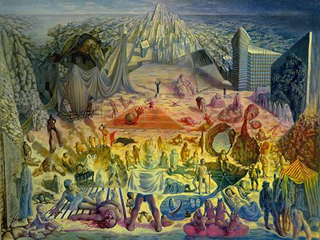
PHENOMENA for solo piano (2000-2002)
painting (left) by Pavel Tchelitchew
American, born Kaluga, Russia, 1898 – 1957
Final Sketch For Phenomena, (1938)
Oil on canvas
35 x 45 3/4 in. (89.0 x 116.2 cm.)
read about Tchelitchew | 1 | 2 | 3 | 4 |
See other artworks | Hide and Seek | Twilight Head
PHENOMENA (2000-2002) is titled after the massive painting of the same name by the Russian emigré Pavel Tchelitchew. Also inspired by a variety of sources in literature and psychology, my “Phenomena” is concerned primarily with irrational forces – specifically mental illness, romantic love, and the subconscious – and with illuminating the links between them. Tchelitchew’s work, strongly influenced by his studies of astrology and alchemy, taps into someplace hidden and powerful. I respond to this particularly spiritual and humane brand of surrealism, this access to inner and outer worlds; hence my appropriation of his title for this piece of music, which explores some of the more occult aspects of our humanity.
The three movements are entitled “Manic/Panic,” “Moment of Mortality,” and “REM.”
I
In “Manic/Panic” I imagine what the internal world of a hypomanic might sound like. The music obeys a kind of logic that is mercurial, discursive, bizarre, perverse, humorous, restless, and violent. “Manic/Panic” begins in medias res, in the middle of high mania, and remains there for the entire length of the movement, using high piano virtuosity and physical stamina, rhythmic/motivic complexity, varieties of gesture and harsh tone-color to conjure this state of mind. The middle section of the movement is an extended “panic attack” which serves as a counter-subject (or counter-topic) to the mania, and pushes the intensity to a different, if parallel level.
The writings of artists such as Vaslav Nijinsky and Gerard de Nerval, who were certainly manic and schizophrenic, were valuable resources to me; from their works I learned how they were able discern a truly human and beautiful logic amidst what must have been frequent and horrible hallucinatory episodes.
II
In the Japanese film “Afterlife,” dead souls enter a kind of purgatory (set in an ancient, tumbledown rural boarding school) and must remain there for a time watching videotapes of their entire lives. They each must select one moment from their own videos to take with them into the infinite, and this will be the only artifact of their life on earth that they will ever possess. The movie concerns itself with the various souls passing through and their struggles to come to terms with these ‘moments’ in their lives.
Not yet having had a chance to reflect on my entire life from a cinematic bardo, I wrote this movement instead, describing a moment that I might actually have experienced and projecting it into the “afterlife” (rather, death). Hence “Moment of Mortality.”
This music is concerned with love and death, with impermanence, with the incredible fragility of a tender moment: a state of romantic bliss shattered by a vision of death and the sudden and permanent loss of that moment. After a violent juxtaposition of three disparate musical sections, the movement finally ends in a kind of hypnagogic (half-asleep) state, like that in which I would imagine the Japanese souls to be as they pass into the afterlife with their precious videotapes.
III
“REM,” or “Rapid Eye Movement,” is the most important type of sleep. Each night we pass through a number of cycles, each consisting of five stages, and REM is the last and longest of these. In REM sleep, our brain paralyzes our bodies, but our eyes twitch back and forth and our eyelids flutter. What is going on in our brains during REM sleep? If we were awakened at any time during REM sleep, what would we interrupt? When we finally awake in the morning, what does the residue of dreams tell us about ourselves? All of our answers to these questions are incomplete, and this final movement is my own incomplete answer.
If sleep is near to death, then we find ourselves there at the end of the second movement. But here we also find sleep near to the manic logic of the first movement. As the composing of “REM” progressed towards the most turbulent and quickly-changing passages of its penultimate section, I found that bits and pieces of “Manic/Panic” and “Moment” hovered, disguised in dream-fabric, wanting to re-appear. A kind of watery grave, this movement is concerned with the catharsis and revelation of sleep; and the revelation for me was not a sense of evanescence, but a confirmation that both the hypomanic and ardent lover’s experiences of cosmic inter-relatedness were available to me in my own sleeping body.
*******
“…The answer received was the first and only one; we knew nothing of other possible answers. It pleased and satisfied me. To ask the same question a second time would have been tactless and so I did not do it: ‘the master speaks but once.’ The heavy-handed pedagogic approach that attempts to fit irrational phenomena into a preconceived rational pattern is anathema to me. Indeed, such things as this answer should remain as they were when they first emerged to view, for then only do we know what nature does when left to herself undisturbed by the meddlesomeness of man. One ought not to go to cadavers to study life.”
—Carl Jung, from the Forward to the I Ching or Book of Changes